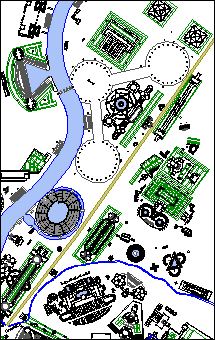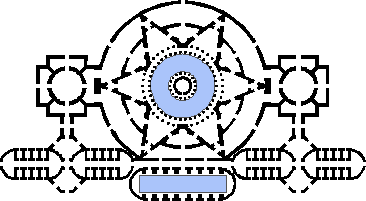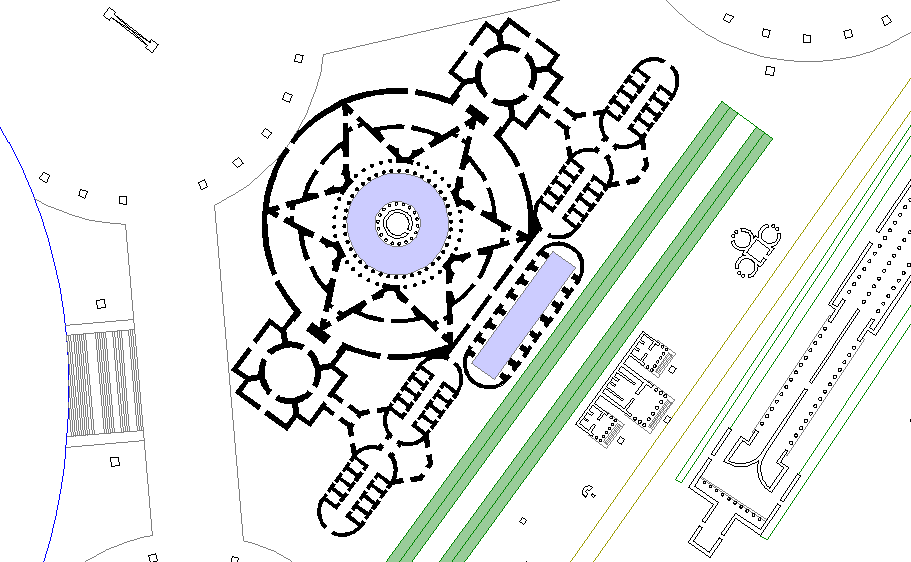Vincenzo Fasolo, "The Campo Marzio of G. B. Piranesi".
2691e
1956
Tafuri text
1996.09.02
Mars (Martis)
1998.07.23
Another of the Ichnographia's three major axes is the race course of the Equiria, the annual horse races held in honor of Mars. Piranesi delineates the course as a relatively straight path running the length of the Ichnographia's northern sector, beginning in the south at the Petronia Amnis (which is, however, incorrectly placed within the plan) and ultimately reaching the outskirts of Rome at the plan's edge. With the exception of a few private gardens on a hill overlooking the Equiria, all the structures along the course relate directly to the Equiria or to the military in general. Three long porticos, the Porticus a S.P.Q.R. Amoenitati Dicata, the Porticus Vipsania, and the Porticus Alexandri Severi, line the course, and no doubt are meant to accommodate the spectators of Rome's premier "fest". The buildings and areas related to the military include, the Officinae Balistarium (manufactory of ballista), Officinae Scorpiorum (manufactory of scorpions), the Naumachia Domitiani (a large amphitheater designed for the show of mock naval battles), three Circulus (large circular areas for military drills and exercises, and finally the Officinae Armorum and the Officinae machinarum militarium (manufactories of military arms and machines). Not only do these buildings pay respect to Mars as the god of war, but, as a cohesive group, they essentially constitute Rome's "Department of Defense".
| |

The Equiria (the broad gold line running from the lower left corner to the upper right corner) spans the Ichnographia's northern region, and the course itself runs in an almost true north-south direction.
|
Aedes Vulcani
Officinae Armorum
Officinae machinarum militarium
1998.12.01
aedes : a dwelling of the gods, a sanctuary, a temple, a simple edifice, without division into smaller apartments, while templum is a large and splendid structure, consecrated by the augurs, and belonging to one or more dieties; but after the Augustan period aedes was used for temple
officina : a workshop, manufactory
officinae armorum : a manufactory of arms
machina : a machine, i.e., any artificial contrivance for performing work, an engine, fabric, frame, scaffolding, staging, easel, warlike engine, military machine
militarium : of the military
Volcanus (Vulcanus) : Vulcan, the fire-god, son of Jupiter and Juno
|

The military machine complex of the Aedes Vulcani, the Officinae Armorum, and the Officinae Machinarum Militarium, which Piranesi postions near the north end of the Equiria, is both literally and figuratively the star of the Equiria's overall military program. This group of buildings represents the manufacturing headquarter's of ancient Rome's armed forces. It is thus a center of civic pride as well as a tribute to Mars, and its placement along the Equiria is entirely fitting, even though the whole design is without historical or archeological substantiality.
Tafuri, a late 20th century Italian architectural historian, describes the Officinae machinarum militarium as a "clockwork mechanism, in which, however, there is an independence of the parts and a lack of interest in formal qualities." Unfortunately, he failed to recognized the overriding "martian" theme of Piranesi's Equiria design, and only scrutinized the geometry of the military factories. Even more disappointing is the fact that Tafuri did not seize upon the appropriateness of associating "clockwork" with factories. In Piranesi's defense, the spaial layout of the Officinae machinarum militarium and the Officinae Armorum is extremely connective because of the many door openings throughout the complex, a quality completely suitable for manufacturing and assembledge processes.
| |
In the center of the Officinae machinarum militarium is the Aedes Vulcani, a small circular temple or shrine surrounded by a circular pool of water and dedicated to the god of fire. The Officinae machinarum militarium itself is a six pointed star shaped plan within a circular perimeter wall, with two small cruciform wings at either end. The Officinae Armorum is essentially four sets of linear celled buildings divided into pairs with a long pool building inbetween. Together, the three buildings comprise a bi-laterally symmetrical composition whose many openings create a complex of abundant connectivity.
On a purely figurative level, the complex's plan resembles a military insignia of honor.
|
| |
Circulus
Ludus
1998.12.01
Equiria
1998.12.01
The buildings along the Equiria related to the military are: the Officinae Balistarium, the Officinae Scorpiorium, the Templum Castrum, the Naumachia Domitiani, three Circulus with two Ludus, the Officinae Armorum with its attached Officinae machinarum militarium, the Templa Jovis Martis Veneris, and an Aedicula Isidis, all of which translate into a ballista factory, a scorpion factory, a temple dedicated to Castor (the guide to mariners), a stadium for the show of mock sea-fights, exercise fields, a factory for arms and military machines, and a triple temple dedicated to Jupiter, Mars, and Venus and chapel dedicated to Isis. These buildings, moreover, are interspersed with "statues of illustrious men" as well as the sepulchers of many distinguished military figures from Roman history. This concentration of military functions essentially constitutes a design for ancient Rome's main military headquarters.
|


